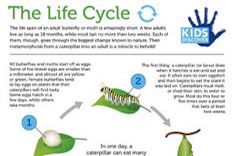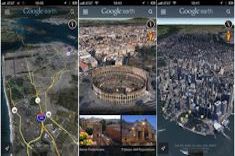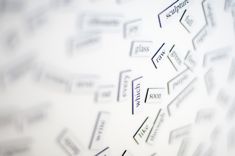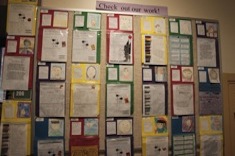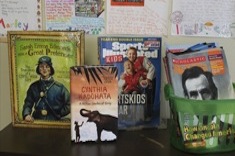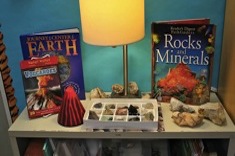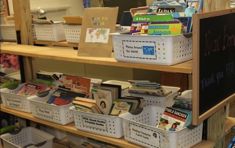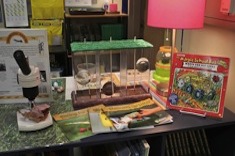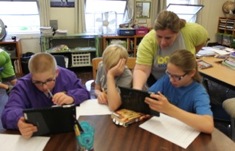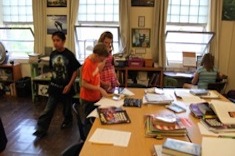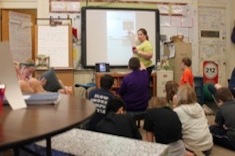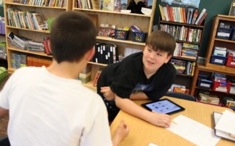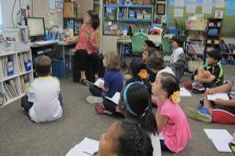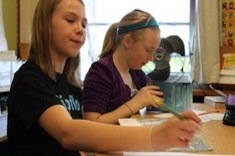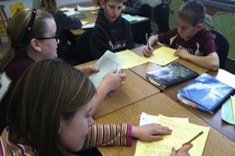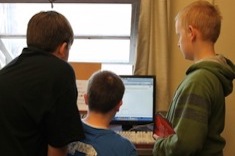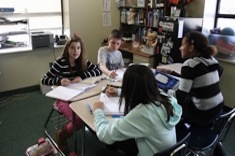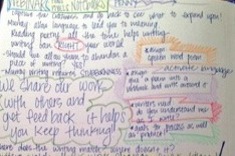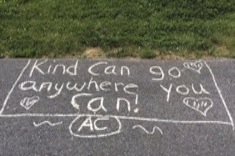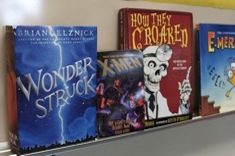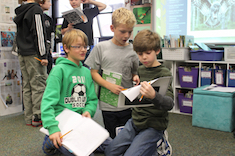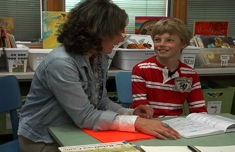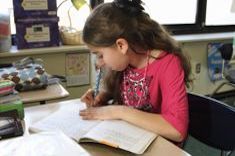5th
Latest Content
Integrating Paraprofessionals into Reading Workshops
Justin Stygles decides he needs to completely rethink the role of classroom aides.
Digital Status of the Class
Maria Caplin explains how a digital status sheet saves minutes every week that add up to extra hours of instructional time over the year.
Infographics and the Common Core: Resources and Standards
Andrea Smith explains why infographics are more useful than ever in the age of the Common Core, and provides many links to free infographic resources on the web.
Using Google Earth to Support Readers
Justin Stygles finds Google Earth is a marvelous tool for helping students research settings in novels.
Teaching Search Skill Basics to Students
Bill Bass has advice for teaching web-based search skills to students.
Webquests with Middle School Students
Megan Ginther revisits a classic internet research project.
The Power of Written Blind Word Sorts
Max Brand uses written blind word sorts to build student word learning skills.
Going Public with Word Work
Maria Caplin is discouraged at the low level of transfer of new vocabulary in her fifth graders’ writing, so she makes some changes in her classroom.
Blurring Genres and Real-Life Readers
The line between fiction and nonfiction can be fuzzy, but Tony Keefer finds what matters most is finding texts that captivate readers.
Classroom Displays for Nonfiction Learning
Andrea Smith shares some of her favorite nonfiction classroom displays.
Exploring Literary Nonfiction with Middle School Students
Holly Mueller and her middle school students have fun exploring the creative aspects of literary nonfiction.
Explore: Time for Nonfiction
Andrea Smith uses Explore Time with her fourth graders to build interest in nonfiction.
Twitter in the Classroom
Katherine Sokolowski and her students find Twitter is an essential element in their fifth-grade reading workshop.
The Power of a Hashtag
Katharine Hale looks at the value of hashtags in helping students harness Twitter in a reading community.
Classroom Management and Student Responsibility
Katherine Sokolowski is discouraged when she observes that some students are off-task during literacy workshops. She decides a reflection sheet will be a useful weekly scaffold to support independent monitoring of behavior.
Integrating Short Videos into Minilessons
Katherine Sokolowski gives advice on how to add video to your literacy minilessons.
Grading in Literacy Workshops
Katherine Sokolowski finds grading student work in her fifth-grade classroom becomes far more interesting when students take responsibility for choosing what will be graded.
Infusing Informational Texts into Morning Meetings: Fact of the Day and Daily News Routines
Andrea Smith explains two routines, Daily News and Fact of the Day, which are key components of her morning meetings.
Shorter Research Projects: Rethinking Notetaking Strategies
Katherine Sokolowski is assigning shorter research projects in her fifth-grade classroom as a way to help students acquire notetaking skills and understand the boundaries of plagiarism.
Peer Evaluation of Student Writing
Megan Ginther found she was spending too much time responding to student writing, and just as important, taking on too much of the responsibility for improvement. She tackled the issue by developing a new program for peer evaluation of student writing.
Rethinking Technology: The Power of Student Experts
It’s impossible to master all the new technology resources available in classrooms, and fortunately we don’t have to. Katherine Sokolowski enlists peers as tech experts in her fifth-grade classroom.
Using Writing Notebooks Authentically with My Fifth-Grade Students
Katherine Sokolowski reflects on a key component of her writing workshop, and finds ways for using writing notebooks more authentically.
Writing Homework
If your students are already comfortable with an unstructured requirement of 20-30 minutes of reading each night, you may find adding 10 minutes of writing at home works wonders in fostering writing skills. Katherine Sokolowski explains how the assignment works in her classroom.
Using Close Reading to Analyze Propaganda
Propaganda, word clouds, and close reading engage students in Holly Mueller’s sixth-grade class.
Spreading Out the Fun
Why save all the most enjoyable literacy activities for May or June? Gigi McAllister spreads out the fun all year long with literacy events and activities to break up routines.
Can Books Harm Children? Support and Censorship
Shari Frost asks a provocative question: Can books harm children? She explores practical ways for teachers to walk the fine line between support and censorship in matching books to students.
Top 10 Intermediate Books for Boys
Katherine Sokolowski finds many of the boys in her classroom love to read about violence, weapons, and crude humor. She challenges teachers to appreciate boys’ interests and set some of our own criticism aside.
Personal Narratives and Memoir: Conferring with Bode
Ruth Ayres confers with Bode about the difference between personal narratives and memoirs, and the value of mining the writing journal for topics.
Rethinking Writing Notebooks
What makes writing notebooks authentic? Katherine Sokolowski ponders the question.
Reading Passports
Justin Stygles develops reading passports as an alternative to traditional reading logs with his fifth- and sixth-grade students.
Browse Content By
Type
Category
- Assessment Tools
- Big Fresh Archives
- Booklists
- Choice Numeracy
- Classroom Design
- Common Core
- Community Building
- Conferring
- Content Literacy
- Digital Literacy
- English Language Learners
- Equity
- Family Relations
- Free Samples
- Guiding Groups
- Leadership
- Literacy Coaches
- Mentor Texts
- Minilessons
- New Teacher Mentors
- Podcasts
- Poetry
- Quote Collections
- Reading Strategies
- Self Care
- Struggling and Striving Learners
- Talking and Listening
- Teacher Study Groups
- Teaching Reading
- Teaching Writing
- Word Study and Vocabulary
Author
- Melissa Quimby
- Nawal Qarooni
- Gwen Blumberg
- Julie Cox
- The Lead Learners
- Hannah Tills
- Josie Stewart
- Ruth Metcalfe
- Mallory Messenger
- Becca Burk
- Jodie Bailey
- Vivian Chen
- Mary Brower
- Tiffany Abbott Fuller
- Stephanie Affinito
- Ruth Ayres
- Leigh Anne Eck
- Heather Fisher
- Shari Frost
- Julie Johnson
- Suzy Kaback
- Gigi McAllister
- Shirl McPhillips
- Melanie Meehan
- Cathy Mere
- Debbie Miller
- Tara Barnett and Kate Mills
- Tammy Mulligan
- Dana Murphy
- Bitsy Parks
- David Pittman
- Brenda Power
- Heather Rader
- Matt Renwick
- Mandy Robek
- Christy Rush-Levine
- Gretchen Schroeder
- Jen Schwanke
- Brian Sepe
- Katherine Sokolowski
- Stella Villalba
- Jennifer Vincent
Grade Level
Choice Literacy Membership
Articles
Get full access to all Choice Literacy article content
Videos
Get full access to all Choice Literacy video content
Courses
Access Choice Literacy course curriculum and training



